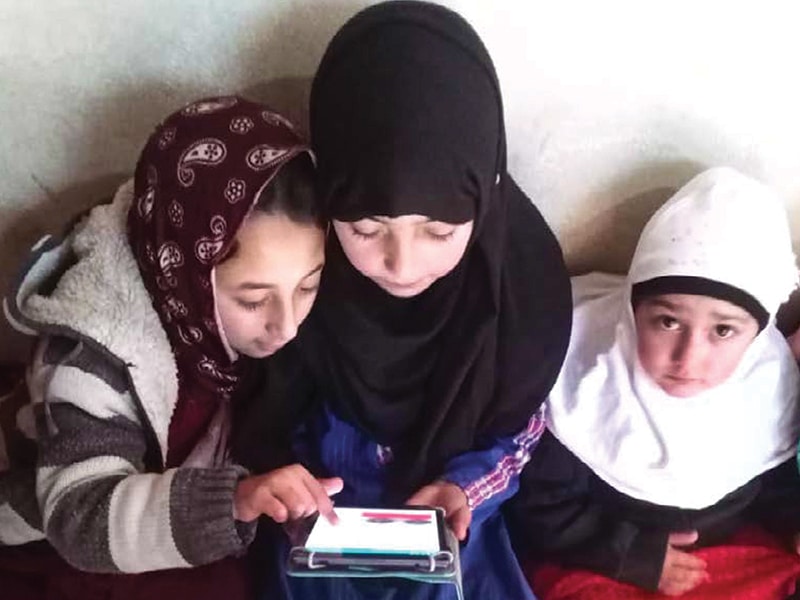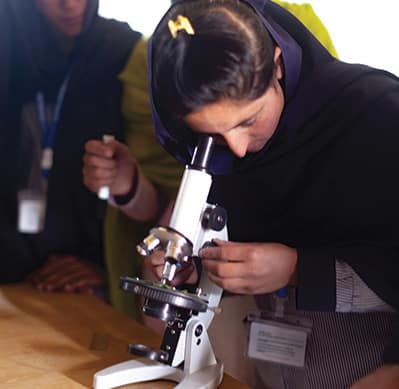Technology lights up learning in northern Pakistan
By Hannah Denys
In many parts of the world, it’s unthinkable to have a classroom without technology. Lessons are projected onto smartboards where students can manipulate the information from their desks, cutting-edge calculators perform advanced equations, and children learn to code in high-tech computer labs.
Yet, in parts of northern Pakistan, technology is still rare. Many schools in these isolated, mountain villages don’t even have electricity. And because they never learn how to turn on a computer, use a smartphone, or search the web—basic tasks in today’s tech-savvy world—hundreds of thousands of Pakistani children are being left behind.
But the good news is, Central Asia Institute is determined to help these kids and their communities catch up.
Turning the classroom lights on
Arando village is the last human settlement in northern Pakistan’s Basho Valley. Heavy snowfall, avalanches, and washed-out roads can cut the village off from the rest of the world for up to seven months at a time. Despite the harsh conditions, 180 families eke out a living in this high-mountain wilderness, farming and raising livestock to stay alive. Without a school, Arando had the highest number of out-of-school girls in the district for many years. That changed in 2021, when CAI established a community-based school in the town. But since power lines couldn’t reach the village, there was no electricity, so students struggled to read their papers and see the blackboard.
Fortunately, CAI donors came to the rescue. With their support, CAI was able to bring electricity to the school through a small solar array that was connected to the school building. Students can now read their lessons in the bright classroom without squinting in the darkness. Everyone in the community is excited about what this means for the future. “Now our girls can get an education and become teachers, doctors, and engineers,” said one father, Mehdi Ali.
Arando was one of six isolated mountain villages to receive solar power thanks to the support of CAI donors. An additional 13 schools received battery-powered generators. These schools have sporadic access to power, so the batteries charge while the electricity is flowing—typically just three or four hours a day. Then, the batteries are used to light the classrooms during power outages.

Technology in the classroom takes learning to a higher level
Getting electricity to classrooms and turning on the lights was just the first step. After that, 64 community-based schools in these remote mountain villages received computer tablets preloaded with three months’ worth of lessons, games, and videos. An additional 15 schools received USB sticks loaded with information and televisions to project the materials.
“In this town, technology was never used in school before,” said Seema, a teacher at a girls’ primary school in Gilgit, Pakistan. “Due to this, students received a lot of benefits and were interested in the lecture because of the videos, pictures, and much more.”
New lessons are loaded onto the tablets and USB sticks every few months, making it easy for schools in places without internet connectivity to access up-to-date materials. An online game and quiz app designed to help children learn was also piloted in these villages. In December 2021, 150 students started testing the app. In the future, CAI hopes to give more students access to the program if it performs well.
These tools enable students to explore new subjects and deepen their understanding of difficult concepts. At the same time, they increase engagement and make learning fun. Visual learning aids like videos can help students better understand and retain ideas. Researchers have found that people don’t remember things they hear nearly as well as things they see.
Getting comfortable with technology while they’re young will go a long way towards helping these children connect with the wider world, apply to university, find professional jobs, and adapt to this ever-changing digital world.

Teachers are the custodians of technology
Teachers in these tiny mountain villages are responsible for guiding students on their path towards technological literacy. But before these e-learning programs were introduced by CAI, many of them had never used a computer or tablet. Some had never even owned a phone. They relied on travelers to take handwritten letters to friends and relatives in nearby towns.
To make them comfortable with their new tools, CAI organized a training where teachers were walked through everything they needed to know step by step—from turning on a tablet or television to opening a browser to playing videos or audio recordings.
After the training, WhatsApp groups were set up so the teachers could communicate with one another and ask questions of support staff. Even though this type of connectivity was new to these educators, they made great use of their new resources. The WhatsApp groups have been especially effective, allowing teachers to reach out to one another to problem solve, exchange ideas, or share words of encouragement.
Continuing education for teachers
For teachers with more technological know-how, CAI offered an online teacher training program. Introduced several years ago, it was designed to help teachers in remote villages continue their education from home. They’re able to learn at their own pace by watching videos and completing reading assignments. Graduates receive a certificate from an accredited university, and credits from the course can be applied towards a university degree.
The program was introduced at an opportune time. Soon after its launch, the COVID-19 pandemic emerged, making it impossible to hold in-person courses. The online program was invaluable in allowing teachers to continue their studies without interruption. The first wave of 30 teachers have successfully completed this program and were awarded certificates.
Technology transformation is on the horizon
While northern Pakistan still can’t be described as a technology hub, slowly but surely, change is happening. For the first time, teachers and students are being exposed to technology, and that technology is opening the door to the larger world outside of their isolated mountain villages.
“One year, two years, or even three years of technology education is not enough to change a life as much as we want,” said Wajeeha Ahmad, assistant manager at CAI’s Pakistani partner organization. “But the initial idea—how tech can be used in school—has begun. Now teachers know that they can use books and technology. And students are absorbing content differently when they see it on screen. Baby steps and sticking with it over the long term—that is how change will happen.”






